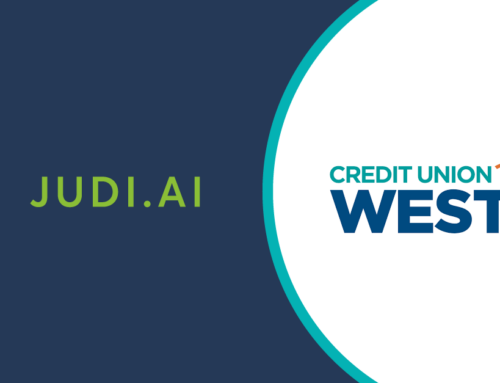We sat down with Ted Kosev, recent addition to JUDI.AI’s Advisory Board, to get his perspective on small business lending and the lessons he’s learned through his experience at traditional banks and fintechs, including Amazon and Square Capital.
- Fintechs have been exploiting the gaps in funding from traditional lenders
- There is significant demand for microlending – don’t neglect it
- Factor in the lifetime value of a small business relationship
- Leverage “alternative data” for credit risk
- Drive portfolio growth with pre-qualified offers
- Leverage transaction data to rightsize the amount to lend
- Design a simplified repayment mechanism
- Optimize for speed and access to capital over rate
- Start with your existing small business base
- Leverage a key competitive advantage – your lower cost of capital
In his eyes, community financial institutions (FIs) have all the attributes required to build successful small business lending programs. If your institution is not active in this segment, his advice would be to make it a part of your growth strategy.
#1. Fintechs have been exploiting the gaps in funding from traditional lenders
Ten years ago, a business with less than $1 million in revenue had maybe a 1-in-10 chance of being approved by a bank – and even then, many didn’t get what they needed. Small businesses were being overlooked by traditional lenders, and fintechs stepped in to meet a huge supply-demand gap.
I joined Amazon in 2011 to start a lending program for sellers on their marketplace. We were probably the first to embed financing into an online platform. We could see how a business was performing, their consistency in sales, growth and other fundamental business metrics. This made it possible to assess their risk and ability to repay in the future so we could make a lending decision without requiring a ton of paperwork from the business. We made it easy for a seller to apply for capital, get a quick decision and receive fast funding. Other platforms like PayPal, Square (which I joined in 2015), Shopify, etc. followed with similar programs. Standalone fintech lenders also emerged, leveraging business transactional data for automated credit risk assessment.
As a result, fintech lenders have grown from near zero to over $20 billion annually in small business loan originations in the last 10 years.
#2. There is significant demand for microlending – don’t neglect it
Community FIs need to offer lending products that are appropriate for small businesses of all sizes, not just the largest ones. Over 90% of small businesses are “micro-businesses”, defined as less than $1 million in revenue. The majority of small business loans are C&I loans under $250k, with many small businesses looking for a much smaller amount, such as a $5K-$10K loan, line of credit or credit card. Frequently, what they find at their local bank or credit union are product minimums they cannot meet and long, cumbersome processes that are geared toward larger commercial enterprises.
To align with this microlending model, community FIs need to streamline their credit application and underwriting processes. This is what fintechs have done successfully to reach over $20 billion in annual originations through millions of loans per year.
#3. Factor in the lifetime value of a small business relationship
Fintech platforms have also seen the benefits of providing access to capital in terms of customer growth and retention. Throughout my experience, I saw that when small businesses took capital they grew their sales, which made them eligible for more funding, benefiting both the small business and the lender. Providing capital can improve trust and significantly lowered attrition for some of the most profitable small business customers.
More than just the transactional value of making a loan, I think that successful fintechs really get the lifetime value of the relationship and are willing to invest in this by creating a fast and easy lending application process with quick turnarounds and funding. The key to enabling this has been underwriting risk using real-time business transaction data which can assess the health and future growth of a business. This, in turn, gives confidence that the borrower will repay the loan.
Banks and credit unions already have access to small businesses and their bank transaction data and I have struggled to understand why they are not exploiting these advantages to grow their small business loan portfolios. I have come to believe that it is a combination of internal prioritization and a focus on transactional profitability vs. LTV. The small business lending segment may seem small relative to large consumer or commercial projects and be difficult to prioritize. In some cases, small businesses are also folded in the broader consumer or commercial portfolio, which leads to inadequate approaches to understanding the customer.
To fully realize the potential from small business lending, traditional financial institutions should treat small business as its own distinct segment, and optimize for the lifetime value of the small business relationship rather than focus on individual loan revenue. For example, providing a $10K line of credit to a business with $200K in annual revenue may allow the business to grow, expand facilities and hire employees. They then qualify for more lending products, sign up for additional banking services, and remain loyal customers. Behind every small business is one or more consumers, who need banking services, mortgages, wealth management, etc. A small business banking relationship can be a key strategic anchor to a broader and long-lasting relationship.
#4. Leverage “alternative data” for credit risk
A key enabler for fintech lenders is the use of real-time transaction data for evaluating risk and ability to repay. Some fintechs such as PayPal, Shopify and Square have their own platform data to do this, but many leverage links to a business’s operating bank account to get similar insights and build robust risk models. Community FIs not only have access to this information, but also enjoy a perception of trust since businesses may already be banking with them. For the ones that aren’t, technology now exists to access that data on a permissioned basis in a seamless fashion.
#5. Drive portfolio growth with pre-qualified offers
For existing customers, FIs can run pre-screen models on bank transactions to find those small businesses that would be eligible for lending and approach them with pre-qualified offers. This would be a best-in-class personalized experience, with potential for high conversion rates for those small businesses seeking funding. Even for those customers that do not need financing, a pre-qualified credit offer demonstrates that the FI values them, and this can boost trust and strengthen the relationship with the FI.
#6. Leverage transaction data to rightsize the amount to lend
Critical to the underwriting decision is determining the amount to lend. In my opinion, this is the biggest challenge for small business credit underwriting. In consumer lending, credit scores and personal income are easy to access and use for determining loan and line limits. In commercial lending, businesses routinely track and report their financials, and employ accountants and finance professionals that can prepare the documentation needed for underwriting a large credit facility.
In contrast, evaluating a small business can be messy! Many small business owners commingle personal and business expenses. Lenders may rely on tax returns to get a financial picture of the business, but this data can be stale and lacks granularity that can show the trends and trajectory of the business.
Successful lenders have learned to use business transaction data to get an accurate picture of the size of the business, their growth trajectory, volatility in revenues and other financial health metrics. FIs should look at deriving revenues and other key financial metrics from a business’s bank account flows. Bank account transactions represent a verifiable source of truth with respect to cash flows and can be used to derive the ability to repay and maximum credit limits for a business.
#7. Design a simplified repayment mechanism
Small business owners juggle many responsibilities and don’t always stay on top of all their bills. Many have experienced falling behind on bills, accruing late charges and fees, and then struggling to get their cash flows back in order. Making repayment hassle-free through auto-pay features and incentives is a simple way to maximize the likelihood of the loan being repaid on time, with small business owners valuing the convenience of not having to remember when exactly a payment is due.
In fact, many fintechs have made automatic payments a required feature of their lending products. This has led to lower loan default rates for the lender, while small business borrowers see the benefits of not incurring penalty fees and a higher likelihood of being eligible for more funding as they make consistent, on-time repayments.
#8. Optimize for speed and access to capital over rate
Small businesses have also been shown to value speed and certainty of funding and be less sensitive to price. This has allowed fintechs to build lending portfolios with high returns. Community FIs can build highly profitable lending portfolios with double-digit risk-adjusted margins, not to mention the opportunities to cross-sell additional business and consumer banking products to the small business ecosystem.
#9. Start with your existing small business base
Acquiring a small business member/customer can cost $2K-$3K, but community FIs already have an existing base of business relationships. In addition, 20% of consumer banking customers are likely small business owners. In my experience, most businesses with less than $1 million in revenue (the vast majority of small businesses) had no other access to business lending when they were approached with a loan offer. All this presents a huge opportunity for FIs to proactively mine their existing relationships and find small businesses looking for funding.
#10. Leverage a key competitive advantage – your lower cost of capital
Comparatively speaking, community FIs have access to low and stable funding costs through deposits. Most fintechs need to charge APRs in the high teens and even 20-30% to be profitable. In the current interest rate environment, a community FI can offer very competitive options, with rates in the teens. With rising interest rates being top of mind for many, this can be an advantage in attracting small businesses that are more established and price sensitive.
***
Thinking about growing your small business lending portfolio?
Scaling a successful small business lending program could be simpler than you think. Looking for someone to bounce ideas off of? Ted Kosev brings to JUDI.AI’s Advisory Board over 20 years of experience with both traditional and fintech lenders for small businesses, including Square Capital and Amazon Lending.
Get the conversation started by booking a complimentary, informal, no-commitment 1:1 consultation with Ted.




